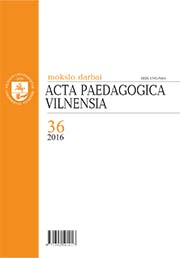Artefaktai bendrojo ugdymo mokyklose: laisva ar sunorminta kūryba?
Artifacts in general education schools: open or standardized creative work?
Author(s): Sandra KairėSubject(s): Visual Arts, School education, Sociology of Culture, Present Times (2010 - today)
Published by: Vilniaus Universiteto Leidykla
Keywords: school culture; visuality; artefacts; creativity; surveillance;
Summary/Abstract: The paper focuses on the artefacts produced and displayed by pupils in Lithuanian general education schools. Drawing on the empirical research “Dominant and demotic school culture: analysis of tensions fields” (2014–2015) the paper investigates the found visual artefacts in schools: artworks, paintings, and graduates’ farewell gifts. The visual data analysis seeks to find out what is the purpose and meaning of the displayed artefacts to the members of school community. On the one hand, these artefacts demonstrate pupils’ creativity, self-expression, and freedom to establish their private spaces in schools. On the Prosser, J. (2007). Visual methods and visual culture of schools. Visual Studies, 22(1), p. 13–30. doi: 10.1080/14725860601167143 Prosser J.; Warburton T. (1999). Visual sociology and school culture. In J. Prosser (Ed.) School culture (p. 82–97). London: Paul Chapman. Peters M.; Marshall J.; Fitzsimons P. (2000). Managerialism and Educational Policy in Global Context: Foucault, Neoliberalism, and the Doctrine of Self – Management. In N. C. Burbules, C. A. Torres (Eds.), Globalization and Education. Critical Perspective (p. 111–132). New York, London: Routledge. Popkewitz, T. S. (2000). Reform as the Social Administration of the Child: Globalization of Knowledge and Power. In N. C. Burbules, C. A. Torres (Eds.), Globalization and Education. Critical Perspective. New York, London: Routledge. Ranciere, J. (2009). Notes on the photographic image. Radical Philosophy, Vol. 156, p. 8–15. Prieiga per internetą: http://m.friendfeed-media.com/701009c 0a81ed6de4eee7407ae43d38b274b4fbc [žiūrėta 2015 m. gegužės 20 d.]. Rose, G. (2012). Visual Methodologies: An Introduction to Researching with Visual Materials. Los Angeles, London: Sage. Survutaitė, D. (2015). Unikalios kultūros mokykla. Švietimo problemos analizė, 3(127). Prieiga per internetą: https://www.smm.lt/uploads/lawacts/docs/5 75_2ee579ef9843cbbecdfacb0afa5c5158.pdf [žiūrėta 2015 m. gruodžio 28 d.]. Thomson, P. (Ed.) (2010). Doing visual research with children and young people. London and New York: Routledge. Želvys, R. (2009). Švietimo politikos kontekstas. L. Duoblienė, T. Bulajeva (Sud.), Lietuvos švietimo politikos transformacijos (p. 13–32). Vilnius: Vilniaus universiteto leidykla. ARTEFACTS IN GENERAL EDUCATION SCHOOLS: OPEN OR STANDARDISED CREATIVE WORK? Sandra Kairė, Lilija Duoblienė Summary other hand, pupils cannot avoid the existing norms, open or hidden control, which is maintained by teachers and school administration in order to restrict and standardize pupils’ creative work as it was showed by M. Foucault and other authors. The paper shows that one part of school community sees artefacts as a way to express oneself, demonstrate one’s world view or even resist existing restrictions and norms. Whereas the other part of school community sees artefacts only as a way to decorate school and create cosiness.
Journal: Acta Paedagogica Vilnensia
- Issue Year: 2016
- Issue No: 36
- Page Range: 42-58
- Page Count: 17
- Language: Lithuanian

